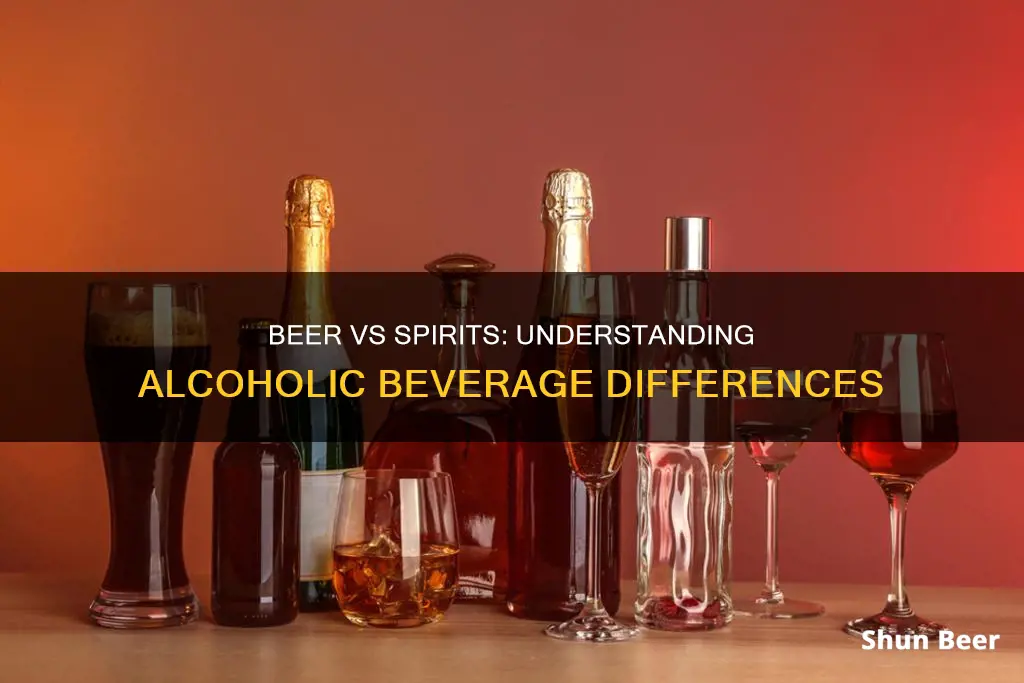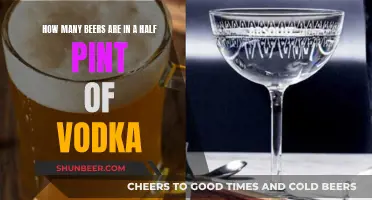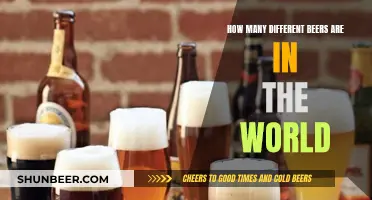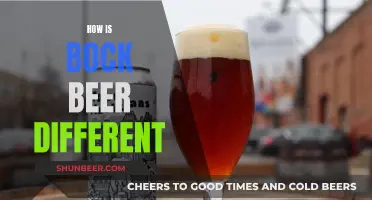
Alcoholic drinks have been consumed for generations, with beer and spirits being two of the most famous beverages. But what's the difference between them? Well, the biggest distinction is in how they're made. Beer is a fermented drink, usually made from grains, while spirits are distilled and can be made from a variety of ingredients, including grains, fruits, and vegetables. Fermentation is a simpler process than distillation, which is why beer is often easier to produce at home. The distillation process also results in spirits having a higher alcohol content than beer.
Differences between Beer and Spirits
| Characteristics | Values |
|---|---|
| Production Process | Beer is produced through fermentation. Spirits are distilled, which involves boiling the fermented liquid and collecting the alcohol that evaporates. |
| Base Ingredients | Beer is typically made from grains, such as barley and hops. Spirits can be made from grains, fruits, or vegetables. |
| Alcohol Content | Spirits generally have a higher alcohol content (ABV) than beer. |
| Taste | Spirits often have a stronger taste than beer, which can be masked by mixing with non-alcoholic beverages. |
| Consumption | Beer is usually consumed over a longer period, while spirits can be consumed more quickly, especially in shot form. |
| Effects | Spirits can produce stronger effects than beer due to their higher alcohol content. |
What You'll Learn

Spirits are distilled, beer is fermented
Alcoholic drinks are made through the process of fermentation. This is a biological process by which sugar is converted into alcohol and carbon dioxide. Yeast is responsible for this process, and alcoholic fermentation is an anaerobic process, meaning oxygen is not necessary.
Spirits are distilled liquors or alcoholic beverages in which the concentration of alcohol has been increased above that of the original fermented mixture. Distillation is a process used to make high-ABV beverages from already-fermented base products. For example, the distillation of beer wort creates whiskey, while the distillation of wine produces brandy. Distillers heat a wort-type liquid or a wine-type liquid to alcohol's boiling point in a device called a still, then cool the alcoholic steam, which condenses into a liquid, resulting in liquor.
Beer, on the other hand, is not distilled but is instead fermented. Beer is made from grain, with most beer made from malted barley, and brewers also using corn, rice, and wheat. These grains are primarily made of carbohydrate molecules, so brewing means transforming those carbohydrates. Brewers create a mash by mixing the grains with hot water. Over a few hours, the ground grain releases sugary sweetness into the liquid, called "wort". The spent grain is then separated from the wort, which ferments into beer.
Therefore, the key difference between spirits and beer is that spirits are distilled, whereas beer is fermented.
Exploring Samuel Adams' Diverse Beer Flavors
You may want to see also

Spirits are stronger
The difference in alcohol content is due to the production process. Beer is made by extracting raw materials, such as malt, hops, or yeast, using water and then fermenting them. On the other hand, spirits are made by refining or distilling grains, vegetables, and fruits. The distillation process involves boiling the fermented product and then condensing the alcoholic steam back into a liquid. This additional step of distillation is what makes spirits stronger than beer.
The higher alcohol content in spirits can lead to stronger effects and faster intoxication compared to beer. A shot of liquor can have more potent effects than a can of beer. Additionally, spirits are often served in cocktails, where the strong flavour of the liquor is masked by non-alcoholic mixers. This can lead to easier overconsumption and a higher risk of abuse.
It is important to note that while spirits have a higher alcohol content, the negative health impacts of alcohol abuse can be seen with both beer and spirits. Excessive alcohol consumption can lead to addiction, liver damage, and other detrimental health consequences, regardless of the type of alcoholic beverage.
Salt Life Beverage LLC: Exploring Their Beer Variety
You may want to see also

Spirits are harder to make at home
Spirits, or liquors, are distilled alcoholic drinks, whereas beers are fermented alcoholic drinks. The process of distillation is what makes spirits harder to make at home.
To make spirits, you need to start with a base. Whiskey, for example, is a grain-based spirit, so you would need a grain such as corn, rye, wheat, or barley. You would need to cook your base at a very high temperature to expose the sugars in the grains, and this needs to be done in water. This step is challenging to get right without the right equipment, as it's hard to gauge the cooking temperature and time accurately.
Once the base is cooked, you need to start the fermentation process by adding yeast to the mixture. Fermentation can take several days, and it's crucial to maintain the correct temperature to ensure the yeast doesn't die. Again, this step can be tricky without the proper equipment.
The next step is where things get even more challenging and dangerous. You need to strain your fermented mixture into a still, which can be extremely dangerous as the production of alcoholic vapour can lead to explosions. This step also requires precise temperature control, as the mixture needs to reach 80 degrees Celsius for the alcohol to evaporate.
After that, the alcoholic vapour needs to be condensed back into a liquid using a condenser with cold water running through it. This part of the process is relatively straightforward, but it is preceded by several complex and hazardous steps.
In contrast, beer-making is a simpler process of fermentation without the need for distillation. While spirits can be made from either the wine or beer method, the distillation process significantly increases the alcoholic content, and this is what makes it harder to make spirits at home compared to beer.
Exploring the Diverse Flavors of Beer: A Tasty Adventure
You may want to see also

Spirits are easier to drink quickly
Spirits are alcoholic drinks that contain ethanol and are produced by distilling grains, vegetables, or fruits. Beer, on the other hand, is made through fermentation. Spirits typically range in strength from 37.5% ABV (alcohol by volume) to sometimes above 50% ABV. Beer has a calorie range that starts from 95-210 calories for a regular-sized, 12 oz bottled drink.
Liquors or spirits tend to have a few additional risk factors associated with them. Firstly, they are often served as cocktails and blended with non-alcoholic mixers, which can mask the taste of hard liquor and lead to overconsumption. Secondly, it takes less liquor to achieve the same effects as beer or wine, leading to quicker intoxication. Thirdly, people tend to consume spirits more quickly, especially in shot form, drinking multiple shots in a short time.
The rapid consumption of any alcoholic drink can be dangerous. Our bodies can typically process about one unit of alcohol per hour, and less for some individuals. If several shots are consumed in a short time, the high concentration of alcohol in the blood can disrupt the body's normal functioning, leading to the risk of acute alcohol poisoning, which can be fatal.
Although spirits are often sipped or mixed with other drinks and consumed slowly, they can also be drunk quickly. Shots, for example, are designed to be drunk in one go and enter the bloodstream rapidly when consumed on an empty stomach. This can lead to drinking more than intended, in a shorter time frame, increasing the risk of accidents or injuries.
Amber vs Lager: Unveiling Beer's Colorful Secrets
You may want to see also

Spirits are easier to mask the taste of
Spirits are often served as cocktails, blended with non-alcoholic mixers and ingredients to create a unique flavour. This can make it difficult to discern the taste of the spirit, and can cause people to consume more than they would otherwise.
There are several methods to mask the taste of spirits. One is to use a mixer with a strong flavour, such as pomegranate or cranberry juice, or a fizzy drink like ginger beer. Carbonation can also help to disguise the taste of alcohol. Chilling a drink can also reduce the ability of taste and olfactory receptors to detect ethanol.
Another method is to filter the spirit through a water filter or activated charcoal, which can remove impurities, oils and sugars, improving the taste.
If you are using vodka, you can try infusing it with chocolate, candy or fruit to mask the flavour. Vodka can also be used in cooking, which disguises the flavour as most of the alcohol is cooked off in the process.
A more unusual method is to add a pinch of baking soda and salt to your drink. This technique has gone viral on TikTok, and is said to neutralise the taste of clear alcohol. However, drinks scientists are sceptical about the validity of this method.
Beer Size Matters: How Larger Brews Differ
You may want to see also
Frequently asked questions
Beer is made by fermenting grains, mainly barley and hops, whereas spirits are made by distilling the result of a previous fermentation.
Distillation involves boiling a fermented liquid, collecting the alcohol that boils off, and then cooling and condensing it into a liquid.
Beer typically has an ABV of between 4% and 6%, whereas spirits tend to have an ABV of around 40% or higher.
Some common spirits include vodka, whisky, gin, rum, brandy, tequila, and various flavoured liqueurs.







